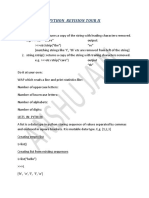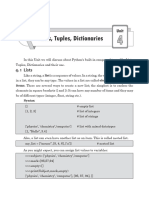Class 9 List Methods Tuple
Uploaded by
kunalaClass 9 List Methods Tuple
Uploaded by
kunalaList Data type:- if we want to represent a group of values as a single entity where
insertion orede to preseved and duplicate are allowed then we should go for list
data type.
i.Insertion order are preseved.
ii.hetrogeneous object are allowed.
iii.duplicates are allowed.
iv.Growable in nature.
v.values should be enclosed within squre bracket.
ex:-
l = [10,56.87,7+9j,True,'string',[1,2,3,4],10]
>>> l
[10, 56.87, (7+9j), True, 'string', [1, 2, 3, 4]]
>>>
list_methods:-
'append', 'clear', 'copy', 'count', 'extend', 'index', 'insert', 'pop', 'remove',
'reverse', 'sort'
1.append:-used for appending and adding element to list.It is used to add element
to the last position of list.
ex:-
>>> l = [10,20,30,40]
>>> l.append(50)
>>> l
[10, 20, 30, 40, 50]
2.Insert:-Insert an element of specified position.
ex:-
>>> l = [10,20,40,50]
>>> l.insert(2,30)
>>> l
[10, 20, 30, 40, 50]
3.extend:-Add contents to list2 to the end of list 1.
>>> l1 = [10,20,30,40,50]
>>> l2 = [60,70,80,90,100]
>>> l1.extend(l2)
>>> l1
[10, 20, 30, 40, 50, 60, 70, 80, 90, 100]
4.count:-calculate total occurrence of given element of list.
ex:-
>>> l = [1,2,3,1,1,1,2,3,3,1,2,2,3]
>>> len(l)
13
>>> l.count(1)
5
>>> l.count(2)
4
>>> l.count(3)
4
>>>
5. index:- Return the index of the first occurrance start and end index are not
nessary parameter.
ex:-
>>> l = [10,20,30,40,50,60,70]
>>> l.index(60)
5
6.clear:- clear the list and get a empty list.
ex:-
>>> l = [10,20,30,40,50,60,70,60]
>>> l.clear()
>>> l
[]
7.copy:- make a duplicate list using this method.
ex:-
>>> l = [10,20,30,40,50,60,70,60]
>>> s = l.copy()
>>> s
[10, 20, 30, 40, 50, 60, 70, 60]
8. pop():- delete the element from last position of the list.
ex:-
>>> l = [10,20,30,40,50,60]
>>> l.pop()
60
>>> l.pop(2)
30
>>> l
[10, 20, 40, 50]
>>>
9.remove():-Element to be deletedis mentrioned using list name and element.
ex:-
>>> l = [10,20,30,40,50,60]
>>> l.remove(20)
>>> l
[10, 30, 40, 50, 60]
10.sort:- converted accending order.
ex:-
>>> l = [1,9,7,8,0,6,8,3,7,11,99,77,90]
>>> l.sort()
>>> l
[0, 1, 3, 6, 7, 7, 8, 8, 9, 11, 77, 90, 99]
decending order.
>>> l = [1,9,7,8,0,6,8,3,7,11,99,77,90]
>>> l.sort(reverse= True)
>>> l
[99, 90, 77, 11, 9, 8, 8, 7, 7, 6, 3, 1, 0]
>>>
11.reverse:- just reverse the list
>>> l = [1,9,7,8,0,6,8,3,7,11,99,77,90]
>>> l.reverse()
>>> l
[90, 77, 99, 11, 7, 3, 8, 6, 0, 8, 7, 9, 1]
>>>
Tuple:-
A tuple is collection of python objects and it's separated by commas. In someways a
tuple is similar to a list in terms of indexing,but tuple immutable.
mutable:- Mutable means we can change or modify the element.
immutable:- immutable means we can not change or modify the element,we can just
watch the data,but cann't change it.
Note:- we can make tuple enclosed with parethesis :- ()
ex:-
>> t = (1,2,3)
>>> type(t)
<class 'tuple'>
You might also like
- Hourglass Workout Program by Luisagiuliet 276% (21)Hourglass Workout Program by Luisagiuliet 251 pages
- The Hold Me Tight Workbook - Dr. Sue Johnson100% (16)The Hold Me Tight Workbook - Dr. Sue Johnson187 pages
- Read People Like A Book by Patrick King-Edited62% (66)Read People Like A Book by Patrick King-Edited12 pages
- Livingood, Blake - Livingood Daily Your 21-Day Guide To Experience Real Health77% (13)Livingood, Blake - Livingood Daily Your 21-Day Guide To Experience Real Health260 pages
- COSMIC CONSCIOUSNESS OF HUMANITY - PROBLEMS OF NEW COSMOGONY (V.P.Kaznacheev,. Л. V. Trofimov.)94% (212)COSMIC CONSCIOUSNESS OF HUMANITY - PROBLEMS OF NEW COSMOGONY (V.P.Kaznacheev,. Л. V. Trofimov.)212 pages
- Donald Trump & Jeffrey Epstein Rape Lawsuit and Affidavits83% (1016)Donald Trump & Jeffrey Epstein Rape Lawsuit and Affidavits13 pages
- The 36 Questions That Lead To Love - The New York Times94% (34)The 36 Questions That Lead To Love - The New York Times3 pages
- The 36 Questions That Lead To Love - The New York Times95% (21)The 36 Questions That Lead To Love - The New York Times3 pages
- Jeffrey Epstein39s Little Black Book Unredacted PDF75% (12)Jeffrey Epstein39s Little Black Book Unredacted PDF95 pages
- The 4 Hour Workweek, Expanded and Updated by Timothy Ferriss - Excerpt23% (954)The 4 Hour Workweek, Expanded and Updated by Timothy Ferriss - Excerpt38 pages
- Securing Windows Server 2016: Official Microsoft Learning ProductNo ratings yetSecuring Windows Server 2016: Official Microsoft Learning Product5 pages
- Ai Unit1 (List, Tuple, Set, Dictionary) PDFNo ratings yetAi Unit1 (List, Tuple, Set, Dictionary) PDF15 pages
- List Vs Mutability:: Once We Creates A List Object, We Can Modify Its Content. Hence List Objects Are Mutable. EgNo ratings yetList Vs Mutability:: Once We Creates A List Object, We Can Modify Its Content. Hence List Objects Are Mutable. Eg100 pages
- Unit Iv Lists, Tuples, Dictionaries Insertion SortNo ratings yetUnit Iv Lists, Tuples, Dictionaries Insertion Sort12 pages
- 11computer Science-List, Tuple and Dictionaries-NotesNo ratings yet11computer Science-List, Tuple and Dictionaries-Notes13 pages
- List Programs (Python Lists & Its Functionality) : # Display of List With ElementsNo ratings yetList Programs (Python Lists & Its Functionality) : # Display of List With Elements7 pages
- 21.3 Get List Size: Ring Documentation, Release 1.2No ratings yet21.3 Get List Size: Ring Documentation, Release 1.210 pages
- Flash Memory Summit 2019 Persistent Memory and NvdimmsNo ratings yetFlash Memory Summit 2019 Persistent Memory and Nvdimms45 pages
- B.Tech. III Year I Semester Regular Examinations, March 2021No ratings yetB.Tech. III Year I Semester Regular Examinations, March 20211 page
- Logical Link Control and Adaptation ProtocolNo ratings yetLogical Link Control and Adaptation Protocol7 pages
- 7.3.2.4 Lab - Attacking A mySQL Database - OK PDFNo ratings yet7.3.2.4 Lab - Attacking A mySQL Database - OK PDF17 pages
- Compactblock I/O For Devicenet: Technical DataNo ratings yetCompactblock I/O For Devicenet: Technical Data52 pages
- EC723 Multimedia Systems (3 0 0 3) : Course Learning OutcomeNo ratings yetEC723 Multimedia Systems (3 0 0 3) : Course Learning Outcome1 page
- PDF 7 Aneis Egberto Gismonti - CompressNo ratings yetPDF 7 Aneis Egberto Gismonti - Compress11 pages
- VMware Examlabs 2V0-21 20 v2021-04-04 by - Aiden - 65qNo ratings yetVMware Examlabs 2V0-21 20 v2021-04-04 by - Aiden - 65q33 pages
- ENGG 200 Introduction To Engineering: Serial Monitor, Analog SignalsNo ratings yetENGG 200 Introduction To Engineering: Serial Monitor, Analog Signals21 pages
- @vtucode - In-Dd&c0 Question Bank With Solution100% (2)@vtucode - In-Dd&c0 Question Bank With Solution31 pages























































































































